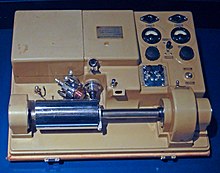Image telegraphy


Image telegraphy , from the English Wirephoto , is a series of methods of remote transmission of images by transmitting electrical signals.
History and Development
The earliest method of picture telegraphy was developed by Arthur Korn between 1901 and 1907. It is based on the semiconductor properties of selenium , which changes its resistance when exposed to light. Nernst lamps were used as the light source . A photo was exposed on a transparent film. This was drawn onto a glass cylinder and scanned line by line. A mirror inside the cylinder threw the light on a selenium cell. At the target point, the electrical signals were converted back into light, with which a film on a corresponding glass cylinder was exposed. The first telegraphic image transmission using Korn's method took place from Munich to Nuremberg in 1904 and took 44 minutes. However, the quality of the transmitted images initially remained unsuitable for practical applications. Only in 1906 were transmissions of sufficient quality and in just 10 to 15 minutes using the Korn method.
In November 1907, regular broadcasts between Paris, Berlin and London began. On March 17, 1908, the first mug shot , transmitted from Paris to London in twelve minutes, was printed in the Daily Mirror . With its help, a volatile jewel robber could be caught.
Another method for transmitting images was developed by Édouard Belin at the beginning of the 20th century. This procedure was based on the formation of gelatin-bichromate reliefs in proportion to the incident light. It was first demonstrated in 1908 and improved in 1926 when Belin replaced the gelatin-bichromate relief with an electric light bulb . This was the method used by the famous "suitcase", the Bélinograph, through which photographers could transmit their images via telegraph and telephone lines.
The picture telegraph, developed before 1938 and shown above, worked according to the following principle: To send the original picture, it was placed on the roller, which rotated and continuously shifted sideways. With a photocell, the respective brightness was recorded via optics (today's term: " scanning ") and transmitted to the receiving device via telephone technology.
For receiving, photographic paper was placed on the roll, which moved at the same speed and feed speed as when scanning; a light source with optics provided a point light that was controlled light and dark by telephone. It took several minutes to transmit an image; it had to be fixed afterwards . The images were almost as sharp as the templates and quite suitable for the press and police searches.
See also
literature
- Max Brückner: Telegraphed pictures. With nine illustrations. In: Reclams Universum 28.2 (1912), pp. 1216-1221.
- Chain keel: image telegraphy ; in: Concise dictionary of electrical telecommunications ; 1st edition, 1st volume A-K; Pp. 146-154; 1929
